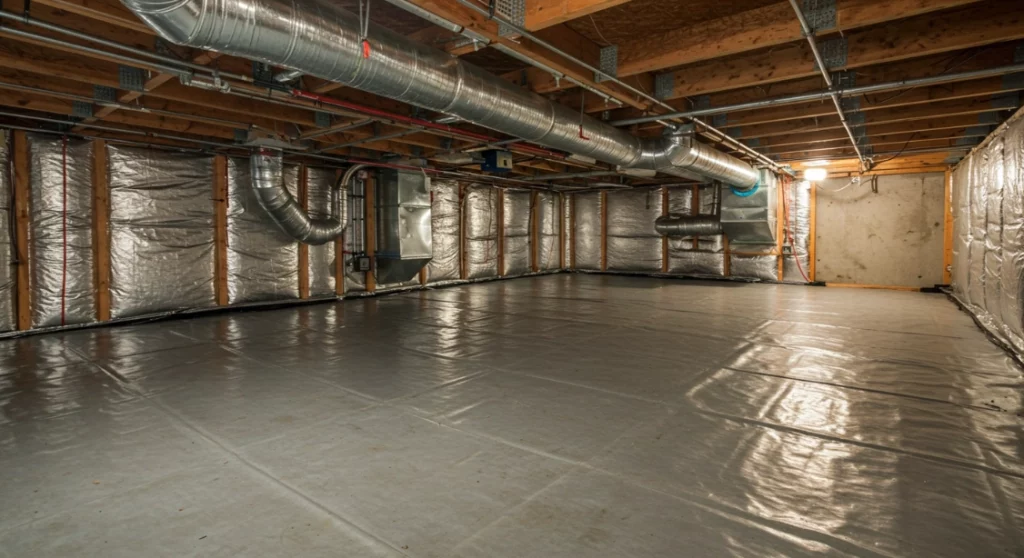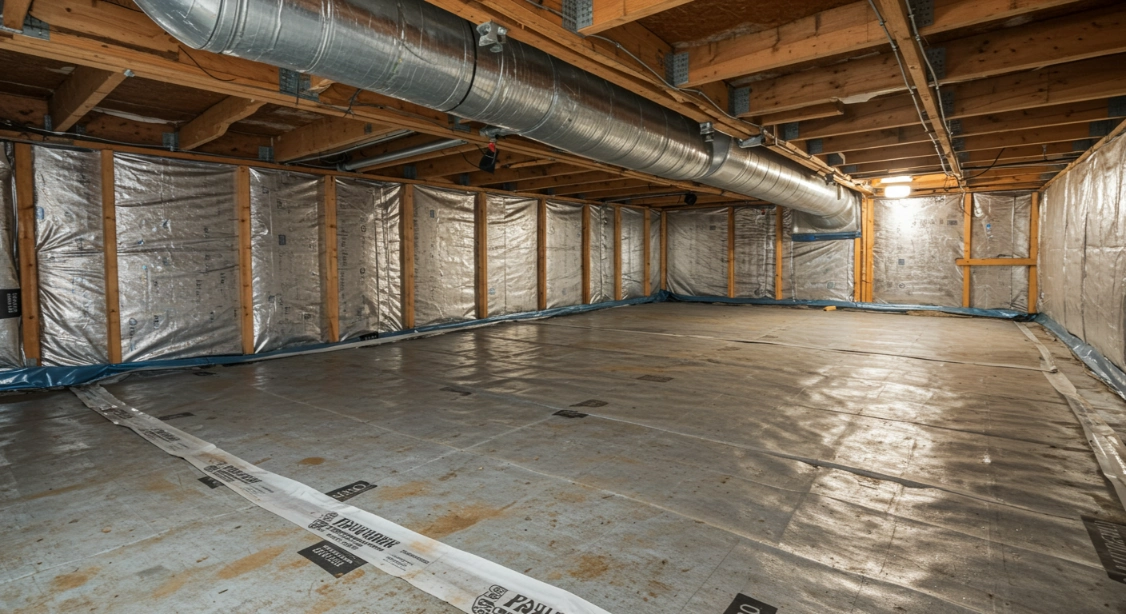Installing a vapor barrier in a crawl space directly reduces moisture intrusion, prevents mold formation, and improves indoor air quality. Vapor barriers block ground moisture from entering the air, helping regulate humidity levels inside the home and protecting structural elements from decay.
This article provides detailed, experience-based information on vapor barrier performance, installation insights, and climate-specific considerations. Content draws on first-hand knowledge gained through insulation and Crawl Space Insulation work across Central Texas. Insights are grounded in field-tested data, ensuring alignment with current building science best practices.
Key Benefits of Vapor Barriers
Moisture Control
Unsealed crawl spaces often allow vapor to rise from the soil, increasing humidity levels that can lead to condensation, wood rot, and mold. Vapor barriers create a physical shield between the soil and floor joists, effectively minimizing moisture exposure.
Energy Efficiency
Reducing crawl space humidity stabilizes HVAC load, leading to more consistent temperature control and reduced energy bills. This benefit is especially relevant in humid regions like Austin, TX, where summer dew points frequently exceed 70°F.
Air Quality Improvement
Up to 50% of indoor air originates from the crawl space. Controlling moisture in this zone lowers the risk of airborne contaminants, allergens, and musty odors entering living areas.
Structural Protection
Moisture-laden air causes long-term damage to wooden framing and subfloor materials. Vapor barriers extend the lifespan of these components by limiting exposure to damp conditions.
Technical Comparison Table
| Feature | Without Vapor Barrier | With Vapor Barrier |
|---|---|---|
| Average Crawl Space Humidity | 65% to 85% | 35% to 50% |
| Mold/Mildew Risk | High | Low |
| Insulation Performance | Compromised by condensation | Maintained due to dry air |
| Wood Rot Potential | Elevated | Significantly reduced |
| HVAC Efficiency | Lower due to moisture load | Improved |
| Indoor Air Quality | Often poor | Noticeably better |
Technical Specifications
| Property | Measurement/Range | Standard |
|---|---|---|
| Vapor Barrier Thickness | 6 mil to 20 mil | 10-20 mil for crawl spaces |
| Material Type | Polyethylene (reinforced) | Class I vapor retarder |
| Perm Rating | < 0.1 perm | ASTM E96 Compliance |
| Installation Coverage | 100% floor, sealed edges | Overlap joints + wall seam |

Practical Tips from Field Experience
- Avoid using 6 mil barriers in areas with frequent flooding; opt for at least 12 mil reinforced polyethylene.
- Always seal seams with butyl tape or compatible adhesive for air-tight performance.
- Extend barriers 6 to 12 inches up walls and mechanically fasten them for full coverage.
Bonus Tip: When installing closed-cell spray foam on crawl space walls, combine with a vapor barrier on the ground to prevent trapped moisture behind the foam.
Climate-Specific Considerations for Texas
Central Texas climate zones (2A and 3A) have high seasonal humidity. In these regions:
- Vapor barriers are highly effective at curbing soil moisture intrusion during spring and summer.
- Sealed crawl spaces with dehumidifiers improve long-term performance.
- Installing barriers in winter allows better curing and lower ambient humidity for setup.
According to data from the Building Science Corporation, homes with sealed crawl spaces in humid climates reduce mold presence by 70% within 6 months (Source: BSC, 2023).
Things to Consider Before Making a Decision
- Crawl Space Accessibility: Ensure sufficient clearance for proper barrier installation.
- Flood Risk: Evaluate if additional drainage is required before installation.
- Material Longevity: Choose reinforced barriers for durability in active soil environments.
- Integration with Insulation: Consider pairing with closed cell spray foam for thermal and moisture protection.
- Code Requirements: Verify compliance with local building codes for vapor retarder use.
Services Stellrr Insulation & Spray Foam Offers for Crawl Spaces
- Crawl Space Insulation: Install open or closed cell spray foam to insulate floor joists and walls.
- Insulation Removal: Remove deteriorated or moisture-damaged insulation from crawl areas.
- Vapor Barrier Installation: Lay and seal polyethylene sheeting to block ground moisture.
- Closed Cell Insulation: Apply to crawl space walls for dual moisture and thermal control.
Common Questions About Vapor Barriers in Crawl Spaces
Is a vapor barrier needed in a dry climate?
Less critical in arid zones, but still beneficial for air sealing and pest control.
Can I install it myself?
Possible in accessible spaces, but requires careful sealing and code compliance.
How long does a vapor barrier last?
High-quality barriers last 15-25 years with minimal maintenance.
Should it go under or over insulation?
Always place the barrier on the ground before insulating the floor or walls.
Get Expert Insulation Guidance
Need help deciding if a vapor barrier is right for your crawl space? Speak with insulation professionals who work daily in Texas homes and understand local moisture challenges.
Contact Stellrr Insulation & Spray Foam. Phone: (512) 710-2839 Email: info@stellrr.com
FAQ
What happens if a vapor barrier is not installed in a humid region?
Excess humidity leads to mold growth, reduced insulation effectiveness, and compromised air quality.
Can a vapor barrier alone control crawl space moisture?
It controls ground moisture but may need dehumidifiers or ventilation for full moisture management.
Is reinforced polyethylene necessary?
Yes, for long-term performance and resistance to tearing during installation and maintenance.
Do vapor barriers attract pests?
No. In fact, they discourage pests by removing damp conditions they prefer.
How do I know if the vapor barrier is installed correctly?
All seams must be sealed, walls overlapped and fastened, and no exposed soil should remain.

